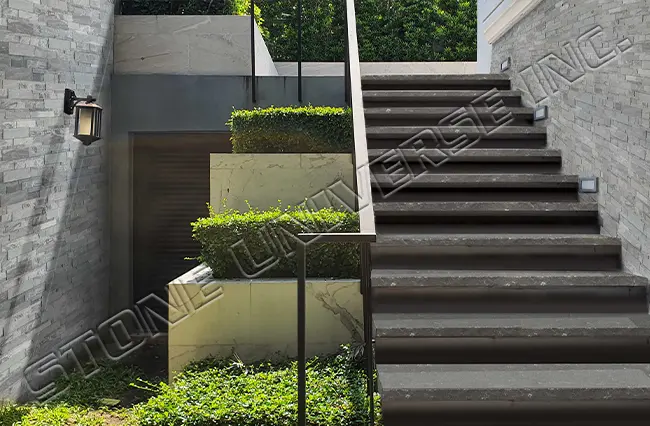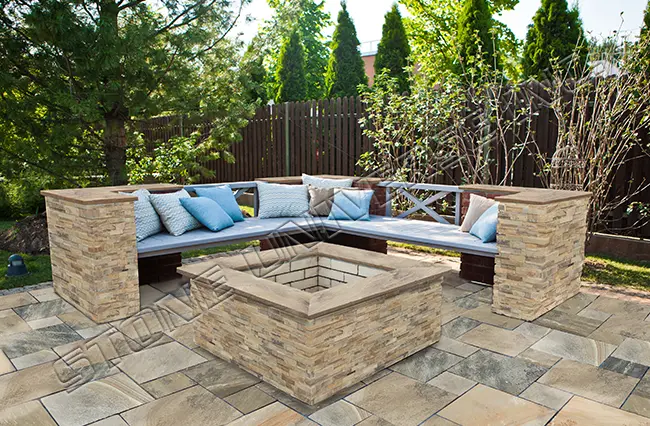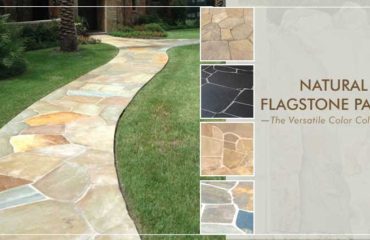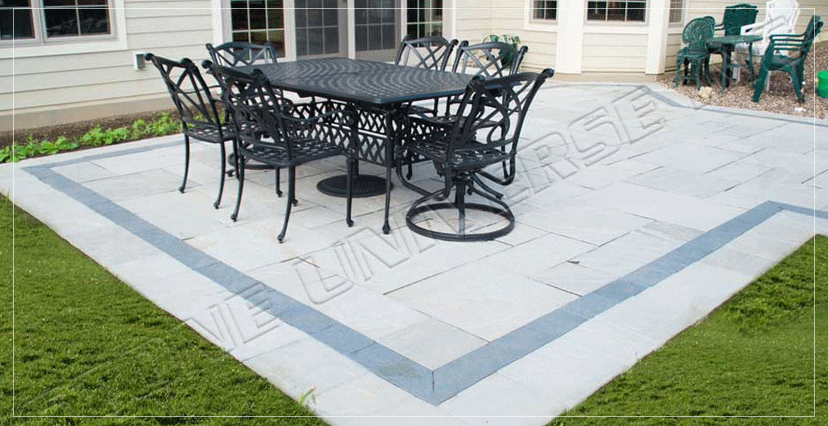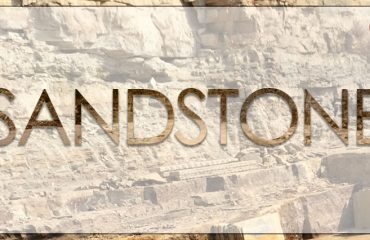Natural stones have been embraced in building and interior decoration since the ages. Basalt, Slate Stone or Sandstone, and Limestone are still common alternatives for anyone remodeling or constructing a new house. These stones do have the natural ability to alter a room and make it uniquely all yours. Additionally, natural stone gives your home’s exterior and interior classic and earthy touch.
These stones are popular among builders because they require little care and are resistant to deterioration, especially in locations with high foot traffic, including foyers and corridors. Keeping the architectural point in view, we are going to study in detail about slate stone and sandstone.
What Is Slate Stone?
Slate is a fine-grained, foliated, homogeneous metamorphic rock obtained from a sedimentary rock of type shale (composed of clay or volcanic ash) under relatively low pressure and temperature conditions. Slate is characterized by fine foliation along which it breaks to leave smooth, flat surfaces. Foliation refers to repetitive layering in metamorphic rocks.
The color of a slate is determined by its mineral composition. Slates usually range from shades of light to dark grey in color. Slate is widely used for external flooring, internal flooring, and cladding. Slate floors are commonly laid in outdoor porches, basements, bathrooms, and kitchens. Internal slate floors are durable, versatile, and elegant.
The natural variation of slate allows homeowners and interior decorators to create unique, one-of-a-kind environments. Slate floors are durable, nonporous, and require little maintenance.
Due to foliation, when the slate is chiseled, it creates a distinctively elegant look compared to other natural and artificial stones which makes it a popular choice for wall caps and column caps.
Tiles are put on mortar during installation, and the edges are grouted. Tiles are frequently treated with chemical sealants to increase or decrease the smoothness of the surface, boost stain resistance, improve longevity and attractiveness, and reduce discoloration. When tiles are sold gauged, the rear surface is ground for ease of installation.
Sneak Peak of Top Slate Stone Trending Design
Slate has been in the trend for ages. Various old monuments are made from slate stone. They give proof of its beauty and durable nature to date. So get yourself inspired with the below-given design ideas of slate stone.
Enchanting Facade Coated with California Gold
California gold is a tumbled slate that depicts a dynamic range of colors from gold rust, browns, and greys. Which creates mesmerizing and stunning interior and exterior surfaces. The robust coloring makes room for inexhaustible design ideas.
Have a look at this inspiring design idea that reminds you of that old rustic touch you can impart to your exteriors gracefully. It would give your entrance a fantastic and an eye catchy look.
Get wow curb appeal with Silver Pearl
Silver pearl a stone with natural finishing and chiseled edges comprises dark variants from black to grey. This vibrant slate stone blends well with other colors to provide lavishing appeal indoors and outdoors.
What Is Sand Stone?
One of the most popular varieties of sedimentary rock is sandstone, which is composed of three elements: cement, matrix, and sediment particles.
Mineral and rock shards make up the sediment particles. Between both the sediment and cement, the intermediate mineral that holds the sediment to the rock, is a fine substance called matrix.
Given the right matrix and cement, sandstone can take on a variety of hues, between white to black, including shades of grey, brown, red, pink, and beige in between. It is an excellent option for both indoor and outdoor use because it is strong and adaptable. Sandstones are utilized indoors as backsplashes, countertops, and flooring.
Sandstone is a great paving material because of its inherent capacity to control heat, specifically for pool sides. It features a built-in anti-slip property, keeps feet cool in the summer, and releases heat during the winter. It can be used to construct walks, retaining walls, patios, porches, outdoor fires, and ovens.
SNEAK PEAK OF TOP SANDSTONE TRENDING DESIGN
Soft To Mellow Grey Hues
Grey Mist– Features a pallet of mellows to dark greys combined with occasional splashes of Rust. Rust spots are general characteristics of the stone. Fairly consistent grey sandstone can blend into a wide range of color schemes creating contemporary and modern designs.
Beautiful Fossil Patterns on The Surface
Autumn Mist -A beige-brown colored sandstone characterized by beautiful, unique fern-like fossil patterns, and brown swirls throughout the surfaces. Every piece is unique and distinct and the patterns add character and enhance the looks of any surface.
Choosing between slate and sandstone might be challenging, but both make wonderful stones for producing premium home signs and many other things. Hopefully, this article will assist you in making a decision.
| DESCRIPTION | SLATE STONE | SANDSTONE |
|---|---|---|
| Type of Rock | Slate is a homogeneous metamorphic rock | Sandstone is a clastic sedimentary rock |
| Composition | It comprises of quartz, chlorite, and plagioclase | It is composed of sand or quartz grains |
| Appearance | Dull | Rough |
| Texture | Foliated and finely grained | Clastic; Medium-grained |
|
Interior use |
Bathrooms, Decorative Aggregates, Entryways, Floor Tiles, Flooring, Homes, Hotels, Interior Decoration, Kitchens, Stair Treads | Countertops, Decorative Aggregates, Interior Decoration |
|
Exterior use
|
Building Stone, Facing Stone, Garden Decoration, Paving Stone | Building Stone, Facing Stone, Office Buildings, flooring |
| Structure | Slate is structured in the form of thin layers | Sandstone is made of clay or silt |
| Historical Monuments | § The Kangra Fort, Himachal Pradesh.
§ Dilwara Temple, Mount Abu, Rajasthan.
§ Qutub Minar, Delhi.
§ Mahishasura Mardini Cave, Mahabalipuram, Tamil Nadu. § Jami Masjid, Champaran, Gujarat.
|
· Abu Simbel in Egypt,
· Agia Sophia in Istanbul, Turkey, · Hawa Mahal in Jaipur, India, · Humayun’s Tomb in Delhi, India, · India Gate in Delhi, |
Decision Time:
Slate is indeed a metamorphic rock, which means it was altered by great pressure and incredibly high temperatures from an earlier rock that was made of volcanic ash. Due to the chemical and physical changes brought on by this tremendous transition, slate has a roughness uniquely its own.
Slate is incredibly adaptable and strong, and it can last for many years. Compared to many other materials, slate takes less upkeep, making it wipe clean to practically any liquids and stain-proof. Slate is renowned for its rich feel and exquisite appearance
Sandstone offers a lot of character and there are numerous color variations from Gray to Brown and Whites to black creating a designer monochrome effect. This type of stone is ideal to be used both indoors and outdoors depending on its durability and versatility.
Sandstone is indeed a sedimentary layer, which means it was created over thousands of years by compressing sedimentary fragments that were at the bottom of lakes, rivers, and oceans. Since sandstone is so durable, builders have been using it for centuries. Sandstone can withstand extremes of temperature, including heat and cold. Using a de-icing substance like salt or spray throughout the winter won’t harm the stone. When wet, sandstone is also not slippery.
So, both these stones have their own features, pros, and cons. The choice among two merely depends upon the colors & textures you want, area of application, and physical properties you are looking for.
 Trade Show 2023: HNA, Oct 18-20, 2023 Louisville, KY - Booth# 30022
Trade Show 2023: HNA, Oct 18-20, 2023 Louisville, KY - Booth# 30022
